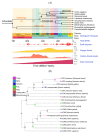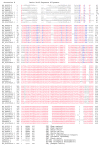Corticotropin-Releasing Factor Family: A Stress Hormone-Receptor System's Emerging Role in Mediating Sex-Specific Signaling
- PMID: 32244319
- PMCID: PMC7226788
- DOI: 10.3390/cells9040839
Corticotropin-Releasing Factor Family: A Stress Hormone-Receptor System's Emerging Role in Mediating Sex-Specific Signaling
Abstract
No organ in the body is impervious to the effects of stress, and a coordinated response from all organs is essential to deal with stressors. A dysregulated stress response that fails to bring systems back to homeostasis leads to compromised function and ultimately a diseased state. The components of the corticotropin-releasing factor (CRF) family, an ancient and evolutionarily conserved stress hormone-receptor system, helps both initiate stress responses and bring systems back to homeostasis once the stressors are removed. The mammalian CRF family comprises of four known agonists, CRF and urocortins (UCN1-3), and two known G protein-coupled receptors (GPCRs), CRF1 and CRF2. Evolutionarily, precursors of CRF- and urocortin-like peptides and their receptors were involved in osmoregulation/diuretic functions, in addition to nutrient sensing. Both CRF and UCN1 peptide hormones as well as their receptors appeared after a duplication event nearly 400 million years ago. All four agonists and both CRF receptors show sex-specific changes in expression and/or function, and single nucleotide polymorphisms are associated with a plethora of human diseases. CRF receptors harbor N-terminal cleavable peptide sequences, conferring biased ligand properties. CRF receptors have the ability to heteromerize with each other as well as with other GPCRs. Taken together, CRF receptors and their agonists due to their versatile functional adaptability mediate nuanced responses and are uniquely positioned to orchestrate sex-specific signaling and function in several tissues.
Keywords: BNST; CRF; GPCR; cardiovascular; diabetes; gut; inflammatory bowel disease; pancreas; reproduction; sexually dimorphic; urocortins.
Conflict of interest statement
The authors declare no conflicts of interest. The funders had no role in the design of the study; in the collection, analyses, or interpretation of data; in the writing of the manuscript, or in the decision to publish the results.
Figures








Similar articles
-
Corticotropin-releasing factor, urocortin 1, and their receptors in the mouse spinal cord.J Comp Neurol. 2007 Jun 20;502(6):973-89. doi: 10.1002/cne.21347. J Comp Neurol. 2007. PMID: 17444496
-
Unraveling corticotropin-releasing factor family-orchestrated signaling and function in both sexes.Vitam Horm. 2023;123:27-65. doi: 10.1016/bs.vh.2023.01.009. Epub 2023 Feb 14. Vitam Horm. 2023. PMID: 37717988
-
Agonist bias and agonist-dependent antagonism at corticotrophin releasing factor receptors.Pharmacol Res Perspect. 2020 Jun;8(3):e00595. doi: 10.1002/prp2.595. Pharmacol Res Perspect. 2020. PMID: 32529807 Free PMC article.
-
Physiological roles of urocortins, human homologues of fish urotensin I, and their receptors.Peptides. 2004 Oct;25(10):1689-701. doi: 10.1016/j.peptides.2004.03.027. Peptides. 2004. PMID: 15476936 Review.
-
From Hans Selye's discovery of biological stress to the identification of corticotropin-releasing factor signaling pathways: implication in stress-related functional bowel diseases.Ann N Y Acad Sci. 2008 Dec;1148:29-41. doi: 10.1196/annals.1410.007. Ann N Y Acad Sci. 2008. PMID: 19120089 Free PMC article. Review.
Cited by
-
Considering Sex as a Biological Variable in Basic and Clinical Studies: An Endocrine Society Scientific Statement.Endocr Rev. 2021 May 25;42(3):219-258. doi: 10.1210/endrev/bnaa034. Endocr Rev. 2021. PMID: 33704446 Free PMC article.
-
Urocortin-1 promotes colorectal cancer cell migration and proliferation and inhibits apoptosis via inhibition of the p53 signaling pathway.J Cancer Res Clin Oncol. 2024 Mar 28;150(3):163. doi: 10.1007/s00432-024-05693-7. J Cancer Res Clin Oncol. 2024. PMID: 38546882 Free PMC article.
-
Physiological and psychological stress reactivity in narcolepsy type 1.Sleep. 2025 Mar 11;48(3):zsae265. doi: 10.1093/sleep/zsae265. Sleep. 2025. PMID: 39546396 Free PMC article.
-
Varied Composition and Underlying Mechanisms of Gut Microbiome in Neuroinflammation.Microorganisms. 2022 Mar 25;10(4):705. doi: 10.3390/microorganisms10040705. Microorganisms. 2022. PMID: 35456757 Free PMC article. Review.
-
Sex, love and oxytocin: Two metaphors and a molecule.Neurosci Biobehav Rev. 2022 Dec;143:104948. doi: 10.1016/j.neubiorev.2022.104948. Epub 2022 Nov 5. Neurosci Biobehav Rev. 2022. PMID: 36347382 Free PMC article. Review.

